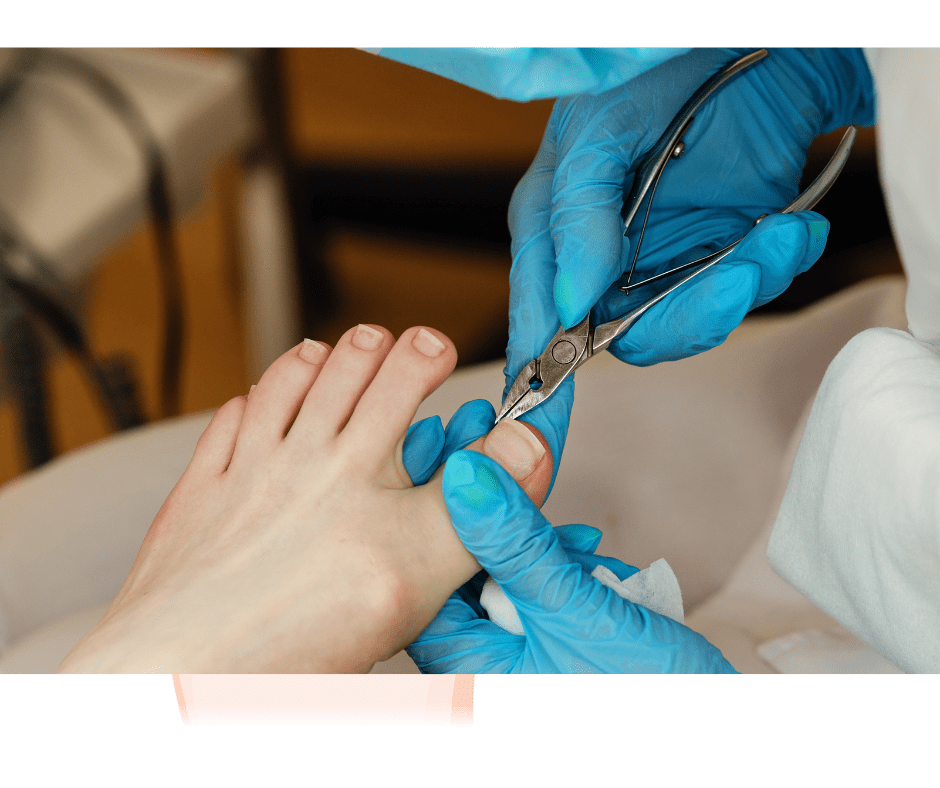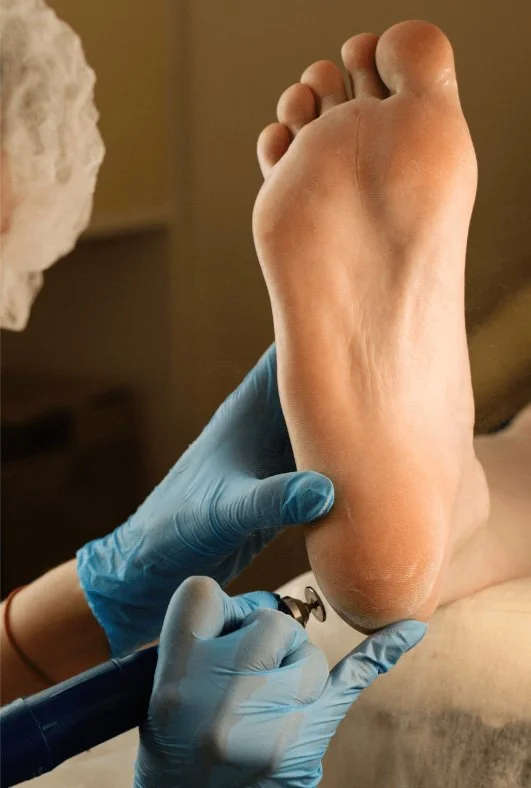
DR. LEE S. COHEN & ASSOCIATES
SPORTS MEDICINE PODIATRY CENTER
SKIN & TOENAIL CONDITIONS
COMMON SYMPTOMS, ISSUES, AND TREATMENT SOLUTIONS FOR SKIN & TOENAIL CONDITIONS
LASER THERAPY FOR FUNGAL TOENAILS
Toenail fungus—also called onychomycosis or tinea unguium—is an infection below the surface of the nail caused by contact with specific kinds of fungi. Nail fungus usually originates as white or yellow spots under the tip of the toenails. However, if its left untreated, the infection can grow deeper and cause the nail to become weak or brittle to the point that it eventually falls off.
Types of Common Fungal Nail Infections
In general, there are four types of fungal infections that affect toes:
Distal subungual onychomycosis (DSO): This is the most commonly diagnosed and treated fungal infection. This consdition is known as athlete’s foot. Athlete’s foot is an infection that spreads across the nail bed and causes the nail to become discolored and weak.
White superficial onychomycosis (WSO): Far less common than Athlete’s Foot, WSO causes white patches to appear across the entire nail.
Candida onychomycosis: This chronic fungus is usually caused by trauma, and it causes the toenails to become bulbous or enlarged.
Proximal subungual onychomycosis (PSO): This fungal infection causes yellow or white spots to appear near the base of the toenail.
Signs & Symptoms of Toenail Fungus
Because there are varying types and levels of severity for toenail fungus, it’s important to have your condition diagnosed by a podiatric physician.
If you are worried that you might be suffering from a fungal infection in your nails, perform a self-evaluation to look for the following common symptoms:
Scaling under the nail
Distorted nail
White or yellow streaks on the nail
Foul odor from the infected nail
Crumbling corner or tip of nail
Flaking white areas on the toenail’s surface
Loss of the nail
How are Fungal Nail Infections Treated?
Laser therapy
Topical cream
Oral medication
Removal of damaged nail or skin.
In severe cases, removing the nail surgically
Treatment isn’t always necessary—depending on the severity of your condition—and because some fungal infections are contagious. Not only can the condition spread to other toes, other people are at risk of contracting your fungal infections as well.
For mild cases of toenail fungus, our podiatrists will likely start with some simple, more conservative forms of treatments. These may include prescription anti-fungal oral medications or topical solutions. For patients who exhibit severe symptoms—or for those who do not respond to medication—the doctor may recommend nail avulsion surgery. This procedure includes nail plate removal and chemical treatments to treat the infection.
Contact Dr. Lee S. Cohen & Associates for more information or to schedule a consultation.
INGROWN TOENAILS
An ingrown toenail—also referred to as onychocryptosis— occurs when the edges or corners of the nail grow into the skin next to the nail. When this happens, the edge of the nail cuts through the skin, which causes inflammation. This inflammation initially presents itself as a minor discomfort, but it could potentially become a recurring problem and can easily become infected.
Causes of Ingrown Toenails
Ingrown toenails are very common—especially in athletes—and most commonly affect the big toe. Common causes of ingrown toenails include:
Poor hygiene
Irregular, curved nails
Poor-fitting footwear
Trauma
Poor posture
Cutting toenails incorrectly
Ingrown toenails may cause no pain at all in some cases. And in others, they can be very painful—it depends on the severity and cause of the condition.
Symptoms of Ingrown Toenails
Common symptoms of an ingrown toenails include:
Pain and tenderness along the side of the toenail
Redness around the toenail
Swelling in your toe
Pus draining from the area
Most of these symptoms do not require medical attention, however you should see a doctor if you experience extreme discomfort in your toe or if you have diabetes (always consult your doctor when having foot pain) or any other conditions that cause poor circulation to your feet.
Diagnosis and Treatment of Ingrown Toenails
Our Podiatrists can diagnose your toe with a physical exam. He or she may also perform an x-ray if the ingrown toenail was caused by an injury, or to show how deep the nail is. If you have an ingrown toenail that is not infected, it can probably be treated at home with various home remedies. Some of these include:
Soaking feet
Pushing skin away from the toenail edge
Using OTC medications
Applying topical ointments to prevent infection
If your ingrown toenail has progressed and become infected, your podiatrist may recommend surgery. Surgery involves removing either all or half of the toenail in an effort to stop the infection altogether. Contact Dr. Lee S. Cohen & Associates with offices conveniently located in Marlton, N.J. and Ridley Park, PA. for more information about ingrown toenail treatment today.
FOOT WARTS (PLANTAR WARTS)
Understanding Plantar Warts
A plantar wart is a hard, grainy growth that are found on the bottom of the foot, in areas where the most pressure is absorbed. Plantar warts occur when the human papillomavirus (HPV) makes contact with the skin on the bottom of the feet. The virus is usually introduced into the body through small cuts or openings on the bottom of the foot.
People with weakened immune systems, children and senior citizens are more likely to develop plantar warts, because they are spread through viral infections.
Types of Plantar Warts
Although most warts are readily visible, some plantar warts grow inwards—due to too much pressure—and form a callous.
The two most common types of plantar warts include:
Solitary wart: One single wart that increases in size and may develop into additional “satellite” warts.
Mosaic wart: Multiple warts clustered together in one area—these warts are usually more difficult to treat.
Symptoms of Plantar Warts
While most cases of plantar warts can go away on their own with time, most people prefer faster relief. The goal of podiatric treatment for plantar warts is to completely remove the wart, not cover it up. Common warning signs of plantar warts include:
Small, fleshy and rough growths develop
Hard, thickened skin forms
Formation of small clotted blood vessels
Pain when walking or standing
Tenderness in the affected area
Our Podiatrists can usually diagnose a plantar wart by completing a simple physical exam. We may remove a section of the lesion to send out for further testing.
Treating Plantar Warts
Laser treatment for warts
Prescription-strength wart medications
Cryotherapy (freezing the wart off)
Immune therapy
Minor surgery to cut away the wart
Schedule an appointment today for a comprehensive evaluation.
CORNS & CALLUSES
Understanding Corns and Calluses
When there is too much friction or pressure on your feet for extended periods, the skin will harden to protect itself—this is when corns and calluses begin to form. Friction occurs when something repeatedly comes into contact with part of the foot. Uneven pressure occurs when your body weight is not properly distributed. Both friction and pressure are thought to be the result of poor shoe choice.
Corns and calluses are very similar in how they form: the skin on the foot becomes thick and rough to the touch. The thickened skin eventually becomes dead tissue, and the layer underneath becomes irritated. This irritation causes pain when pressure is applied to the affected area. However, corns and calluses do form in different areas of the foot: corns are found on the toes, while calluses form on the bottom of the foot
While there is not just one cause of these conditions, poor shoe choice is thought to be the main reason corns and calluses develop. Examples of ill-fitting shoes include:
Causes of Corns and Calluses
Shoes that are too tight or pinch the toes
High-heeled shoes that unevenly distribute weight
Shoes that are too loose and do not fit properly
Shoes that do not provide proper arch support
In addition to poor shoe choice, there are other foot conditions that contribute to the development of corns and calluses—like hammertoe. Those who have foot deformities may also be at a higher risk of developing corns and calluses.
Diagnosis and Treatment
Following a physical examination of the foot, your podiatrist should be able to diagnose your condition. Simply changing your shoes and being more mindful of how shoe choice affects your feet can usually clear up and prevent mild corns and calluses. Your podiatrist may also recommend the following home remedies to eliminate mild corns and calluses:
Padding: To protect the area where the corn is located, you can use small pads that shield the area from friction.
Massage: Rubbing corns and calluses following a shower with a pumice stone or a callus file to eliminate the thickened skin.
Larger corns and calluses may have to be surgically reduced. Our Podiatrists will use a blade to carefully shave away the thickened or dead skin—similar to how a pumice stone works, but much more effective. The procedure is painless and is usually completed on an outpatient basis. A cortisone injection may also be used to reduce pain caused by corns or calluses. Contact us for a complete evaluation.





